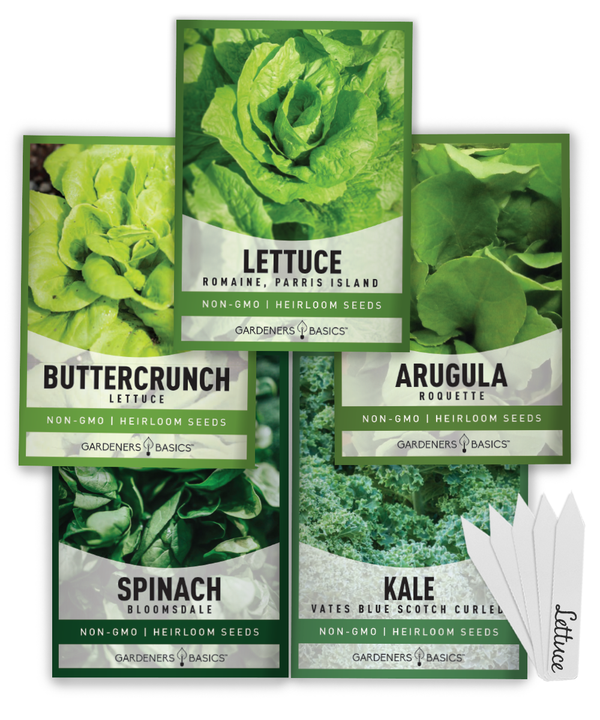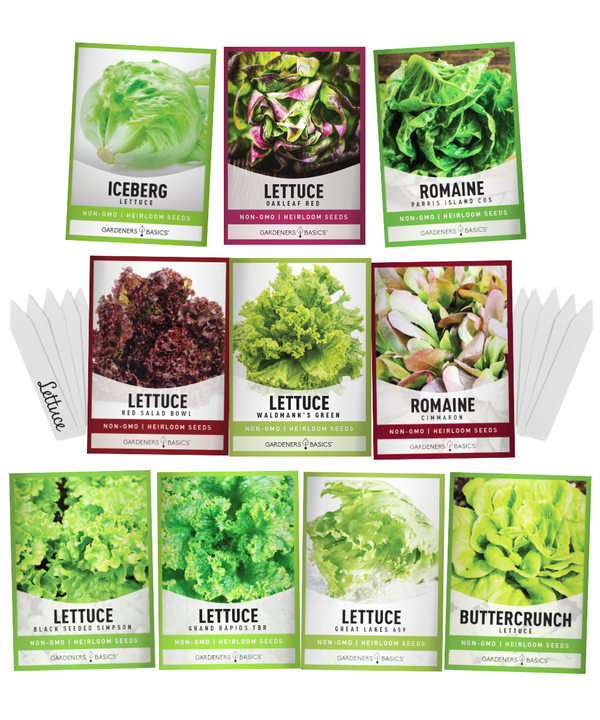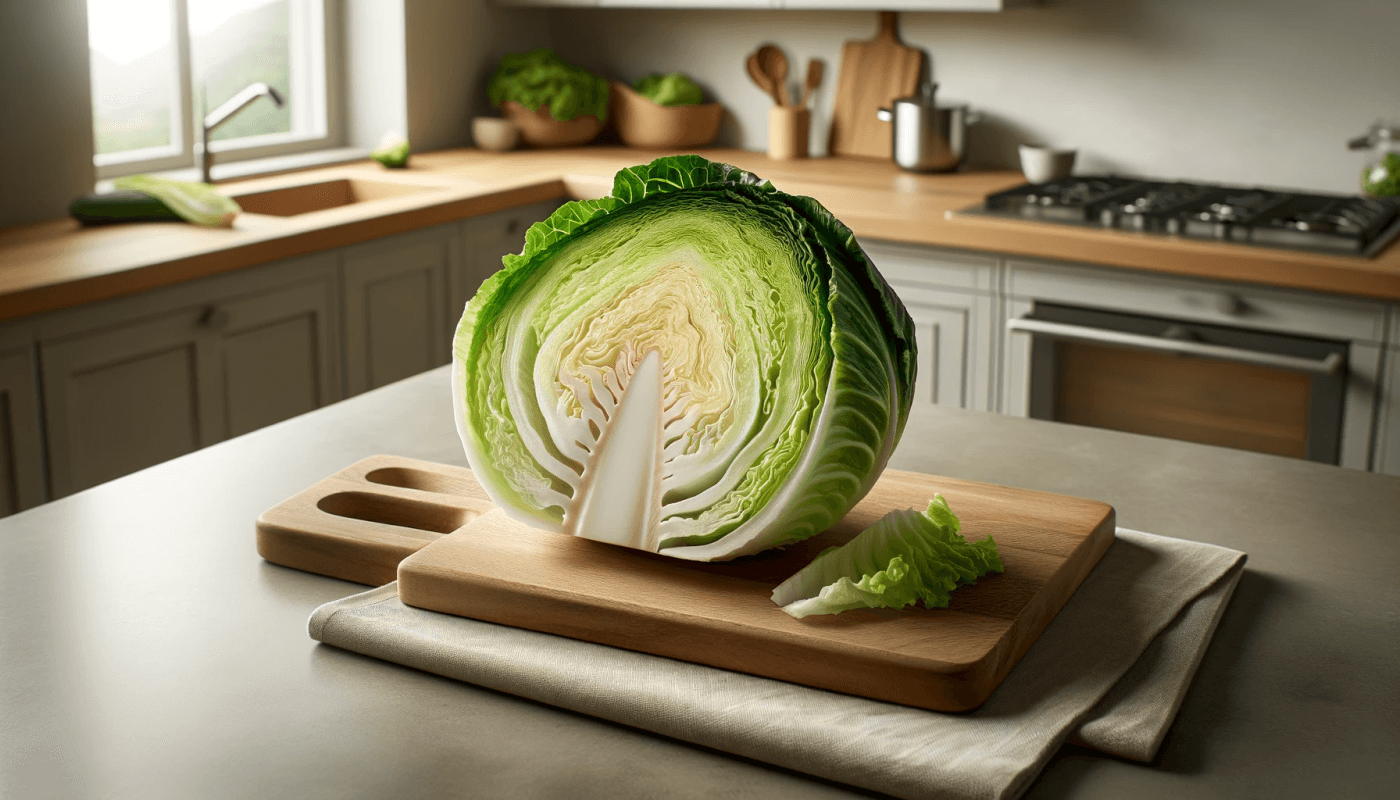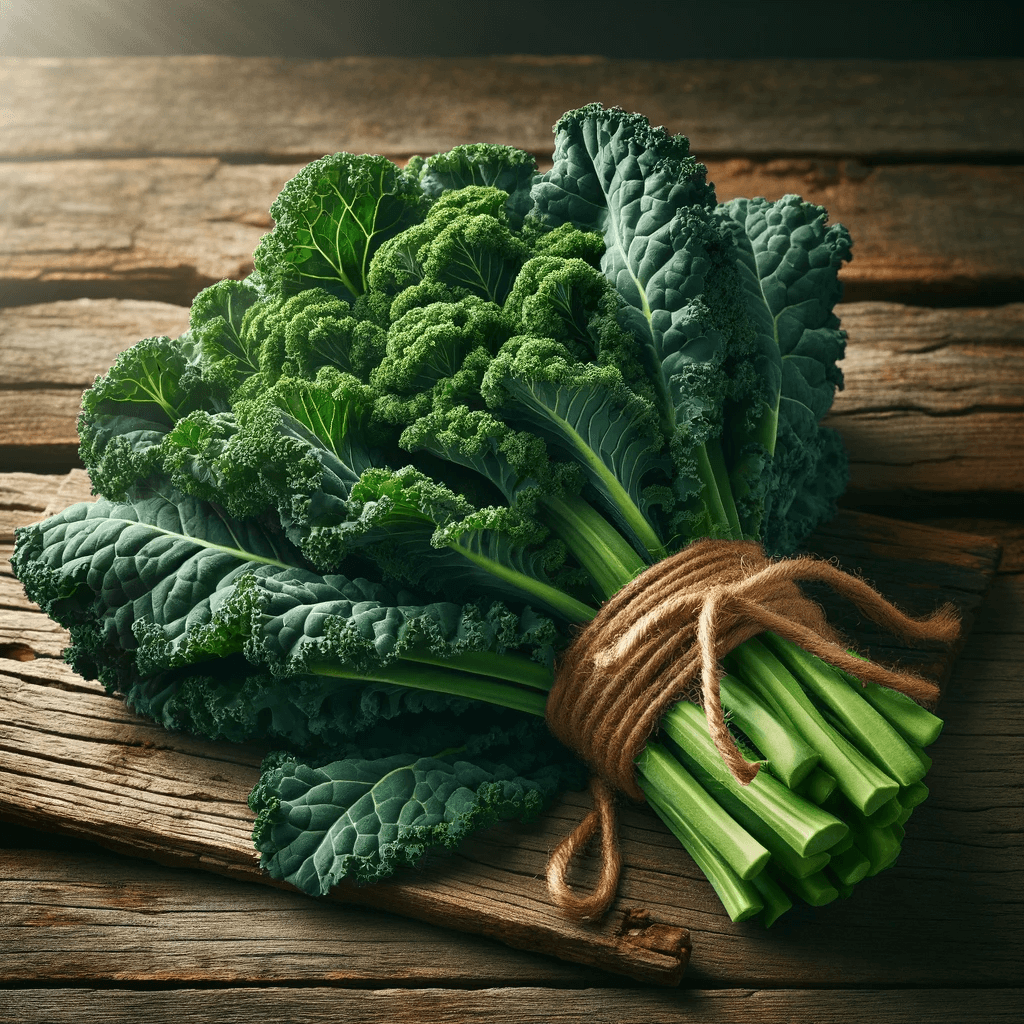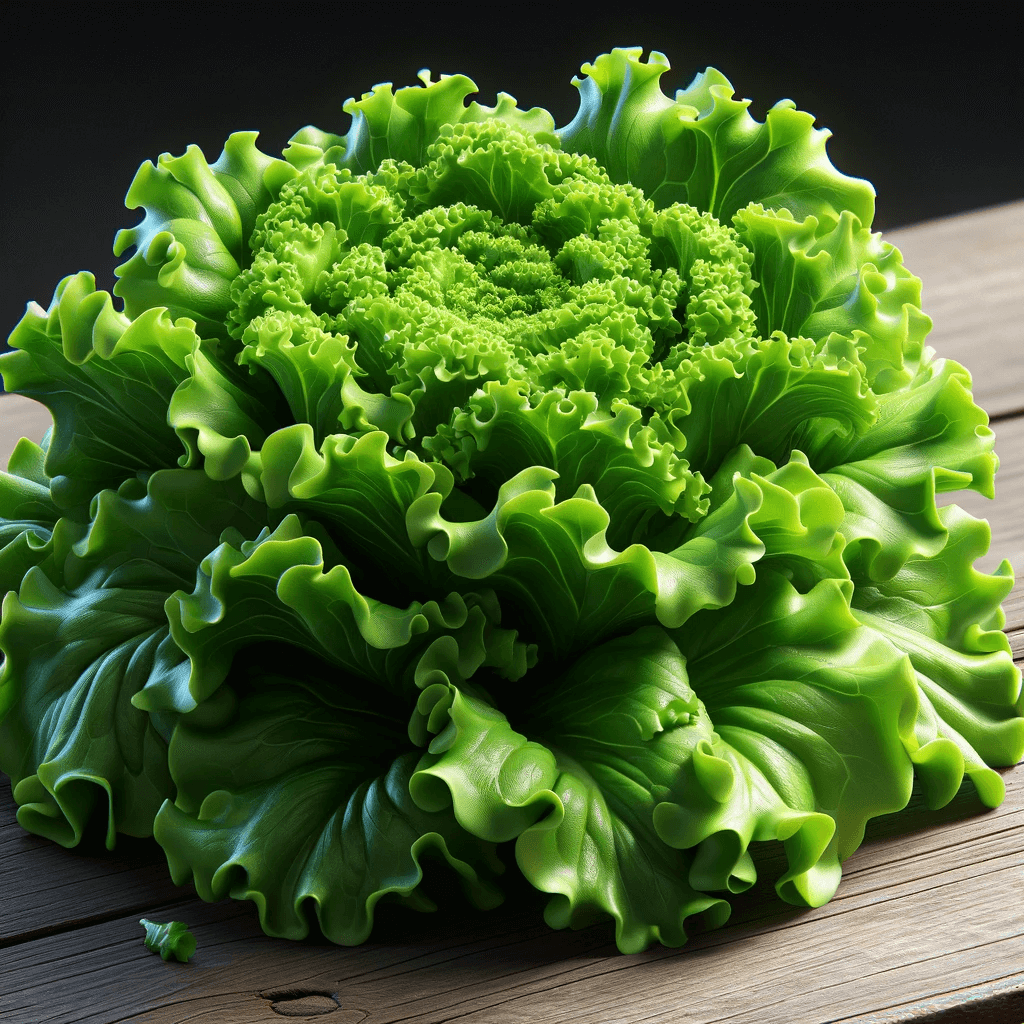Crisphead iceberg lettuce, also known simply as iceberg lettuce, is a popular heirloom lettuce seed variety known for its crisp texture and mild flavor. It is characterized by tightly packed, light green leaves that form a compact head. Learning how to grow crisphead iceberg lettuce from seed is easy and will save you lots of money at the store.
This lettuce variety has been a staple in salads and sandwiches for decades due to its refreshing crunch and versatility in various culinary preparations. Growing crisphead iceberg lettuce from seed offers several advantages over purchasing transplants or relying on store-bought lettuce.
By starting from seed, you have better control over the entire growth process, allowing you to ensure optimal conditions for your plants. Growing from seed grants you access to a vast array of lettuce varieties that may not be readily available at your local grocery store or nursery.
Brief Overview of Crisphead Iceberg Lettuce
- Days till maturity: Crisphead iceberg lettuce typically reaches maturity in 70-85 days from planting.
- Planting depth: Plant iceberg lettuce seeds at a shallow depth of about ¼ inch (0.6 cm).
- Plant spacing: Space the plants 12-18 inches (30-45 cm) apart to allow adequate room for growth.
- Days to germination: Iceberg lettuce seeds generally germinate in 7-10 days, depending on soil temperature and moisture.
- Does it matter if these seeds are started indoors or directly sown? This depends on your climate. Starting seeds indoors 4-6 weeks before the last frost date is beneficial in cooler climates. In warmer climates, seeds can be directly sown outdoors.
- Should these seeds be planted in Full sun or partial shade? Iceberg lettuce thrives in full sun but can tolerate partial shade. In very hot climates, some afternoon shade can be beneficial.
- When to harvest: Harvest iceberg lettuce when the heads are firm and tightly closed, usually around 70-85 days after planting.
- How tall does the plant get? Iceberg lettuce can grow up to 12 inches (30 cm) in height.
- How wide does the plant get? The plant can spread up to 12 inches (30 cm) in width.
- Native: Iceberg lettuce is native to the Mediterranean region.
- Family: The Asteraceae family is a large family of flowering plants.
Crisphead iceberg lettuce belongs to the larger family of leaf lettuces (Lactuca sativa). Unlike other types, such as romaine or butterhead lettuces, harvested as loose leaves, crisphead varieties form dense heads that provide a satisfying crunch. The outer leaves of this variety tend to be darker green, while the inner leaves are lighter in color.
The texture of crisphead iceberg lettuce differs from other lettuces due to its tightly packed leaves contributing to its characteristic crunchiness. While it may lack some vibrant flavors found in other lettuce varieties, its refreshing and mild taste makes it an excellent base for salads or as an accompaniment to more boldly flavored ingredients.
Lettuce Seed Assortment | 5 Variety Pack

$9.95
Grow Fresh Greens Year-Round with Our 5 Lettuce Seeds Variety Pack - Heirloom, Non-GMO, Perfect for Outdoor & Indoor Gardening Introducing our 5 Lettuce Seeds Variety Pack – the perfect addition to your garden, whether you’re a seasoned grower or… read more
Importance of Growing Lettuce From Seed for Better Control and Variety Selection
Starting from seed gives you greater control over your lettuce plants' growth cycle. By carefully selecting high-quality heirloom seeds from reputable suppliers, you can ensure that your plants will thrive and produce desirable heads of lettuce with optimal taste and texture. This control extends to the entire growth process, from soil preparation to watering and harvesting.
Moreover, growing lettuce from seed allows you to explore a vast array of varieties beyond what is typically available in grocery stores. While supermarket shelves usually feature standard iceberg lettuce, numerous heirloom lettuce seeds that offer unique flavors, colors, and textures are available.
Growing your own lettuce from seed allows you to experiment with different varieties and tailor your garden to your preferences. When starting seeds indoors, you have the added advantage of an extended growing season.
By sowing crisphead iceberg lettuce seeds indoors before the last frost date in your area, you can get a head start on the growing season and enjoy fresh homegrown lettuce earlier in the year. This method also provides protection against adverse weather conditions, such as sudden temperature drops or heavy rains that could hinder seed germination or damage young plants.
Understanding the basics of crisphead iceberg lettuce and recognizing the benefits of growing it from seed lays a solid foundation for successful cultivation. The next section will delve deeper into this variety's characteristics and nutritional value to enhance our understanding further.
Description and Characteristics of Crisphead Lettuce
Crisphead iceberg lettuce (Lactuca sativa var. capitata) is popular for its dense, tightly packed heads and crisp, refreshing leaves. It is characterized by its round shape with a flattened base, forming a compact head composed of overlapping layers of light green leaves. The outer leaves are typically thicker and more rigid, protecting the inner leaves.
Compared to leaf lettuce or romaine lettuce, crisphead lettuce has a milder flavor with a hint of sweetness. One distinguishing feature of crisphead lettuce is its ability to retain water within its succulent leaves, making it exceptionally crunchy and refreshing when consumed.
This characteristic also contributes to its extended shelf life compared to other lettuce varieties. When properly grown and harvested at the right time, crisphead lettuce can develop firm heads that are uniform in color and free from issues such as bolting or bitterness.
Nutritional Value and Health Benefits
Crisphead iceberg lettuce may often be associated with its use as a filler in salads or sandwiches; however, it offers numerous health benefits owing to its nutrient-rich composition. While it is low in calories—making it an excellent choice for those aiming to manage their weight—it doesn't compromise nutritional value. This variety of lettuce contains essential vitamins such as vitamins A, K, and C. Vitamin A promotes healthy vision, supports immune function, and helps maintain skin health.
Vitamin K plays a critical role in blood clotting and bone health maintenance. Vitamin C is an antioxidant that boosts the immune system while supporting collagen synthesis for healthy skin.
Moreover, crisphead iceberg lettuce provides dietary fiber that aids digestion by promoting regular bowel movements and maintaining gut health. It also contains minerals like potassium—an electrolyte important for heart function—and small amounts of iron needed for healthy blood cells.
Including crisphead lettuce in your diet can enhance the overall nutritional profile of your meals and contribute to a well-rounded, health-conscious lifestyle. Remember, while crisphead iceberg lettuce offers valuable nutrients, it is important to maintain a diverse diet with various fruits and vegetables to ensure adequate nutrient intake.
Selecting the Right Seeds
When learning how to grow crisphead iceberg lettuce from seed, selecting high-quality seeds from reputable suppliers is crucial for a successful harvest. The quality of the seeds directly impacts the growth, flavor, and overall health of your lettuce plants. We go through seed very quickly, as soon as we get it in. Thanks for trusting Gardeners Basics when you're looking to buy heirloom seeds.
Iceberg Lettuce Seeds

$2.49
Premium Iceberg Lettuce Seeds for Crisp, Delicious Heads – Heirloom, Non-GMO, Non-Hybrid, Open-Pollinated Grow your own fresh, crunchy Iceberg lettuce with our top-quality seeds, perfect for gardeners of all skill levels. These heirloom seeds are non-GMO, non-hybrid, and open-pollinated, ensuring… read more
Preparing the Soil
Optimal soil conditions for lettuce growth
To ensure the successful growth of crisphead iceberg lettuce, it is essential to prepare the soil properly. Lettuce plants have shallow roots, so loose, well-draining soil is crucial for their development.
Start by clearing the planting area of any weeds or debris that may hinder growth. Lettuce thrives in a slightly acidic to neutral pH range of 6.0 to 7.0.
Test the soil's pH level using a home testing kit or by sending a sample to a local agricultural extension office for analysis. If the pH level is below 6.0, consider incorporating lime to raise it gradually over time.
pH level, moisture, and drainage requirements
Once you have determined the pH level, ensure appropriate moisture and drainage conditions. Adequate moisture is crucial for lettuce seed germination and subsequent plant growth. However, excessive waterlogging can lead to root rot and other diseases.
Maintain consistent soil moisture by watering regularly, but avoid overwatering as it can lead to fungal issues and poor plant health. Aim for moist but not soggy soil throughout the growing season.
Good drainage is vital for preventing waterlogged conditions that can harm lettuce plants. If your garden has heavy clay soils with poor drainage, amend the soil with organic matter like compost or well-rotted manure to improve its structure and allow excess water to drain effectively.
Soil amendment recommendations for improved fertility
To enhance fertility in your lettuce-growing bed, consider adding organic matter before planting or transplanting seedlings outdoors. Compost or aged manure provides various nutrients necessary for healthy plant development.
The addition of organic matter not only improves fertility but also helps with moisture retention and overall soil structure enhancement. Mix the organic matter into the soil to a depth of 6 to 8 inches, ensuring it is evenly distributed.
Additionally, consider incorporating a balanced organic fertilizer or slow-release granular fertilizer according to package instructions. This helps provide additional nutrients that may be lacking in your soil.
By preparing the soil properly with optimal pH levels, adequate moisture, and good drainage, as well as enhancing fertility through organic matter and proper fertilization, you are setting a solid foundation for successfully growing crisphead iceberg lettuce from seed. The next step is to start seeds indoors or directly sow them outdoors, following specific guidelines for each method.
The Benefits of Starting Seeds Indoors
Unlocking the Potential for an Extended Growing Season
While others may eagerly wait to sow their seeds directly in the garden, you can get a head start by nurturing your seedlings indoors. This means you'll have mature lettuce plants ready for harvest earlier than your neighbors, giving you a jump on enjoying this delightful leafy green.
Protecting Your Precious Seedlings from Adverse Weather Conditions
Mother Nature can be unpredictable, and adverse weather conditions like late frosts or heavy rains can hinder direct sowing in the garden. However, when you start your crisphead iceberg lettuce seeds indoors, you have greater control over their environment.
You can shield them from inclement weather by keeping them safe and cozy inside until conditions outside are more favorable for transplanting. This protection ensures that your delicate seedlings won't suffer setbacks or damage due to unexpected weather fluctuations.
A Step-by-Step Guide to Starting Crisphead Iceberg Lettuce Seeds Indoors
Following a proper step-by-step guide is essential to maximize success when starting crisphead iceberg lettuce seeds indoors. When you know how to grow crisphead iceberg lettuce from seed, you'll be so proud you can do it yourself. Let's explore some key techniques:
1. Pre-soaking Seeds for Better Germination Rates
Before sowing your lettuce seeds into trays or pots filled with moistened seed-starting mix, consider pre-soaking them overnight in water at room temperature. This process softens the seed's outer coating and encourages faster germination rates.
2. Proper Seed Sowing Techniques in Trays or Pots
Gently sow the pre-soaked lettuce seeds on the surface of the seed-starting mix, ensuring they are evenly dispersed. Lightly press them down into the soil to provide good seed-to-soil contact while maintaining a shallow depth.
3. Providing Adequate Light, Temperature, and Humidity Levels
Place your trays or pots in a well-lit area with ample indirect sunlight. If natural light is insufficient, supplement it with fluorescent or LED grow lights positioned a few inches above the seedlings. Maintain an optimal temperature range of 65-75°F (18-24°C) during the day and slightly cooler at night. To create a favorable environment for germination, cover your containers with plastic domes or plastic wrap to retain humidity until the seedlings emerge.

Transplanting Seedlings Outdoors
Timing considerations for transplanting seedlings outdoors
Transplanting crisphead iceberg lettuce seedlings outdoors requires careful timing to ensure optimal growth and survival. Ideally, wait until the threat of frost has passed in your region before moving the seedlings from their indoor containers to the garden.
A general guideline is to transplant after the soil temperature reaches around 50°F (10°C). If you start your lettuce seeds indoors, they will typically be around 4-6 weeks old when ready for transplantation.
Preparing the planting area
Before transplanting your crisphead iceberg lettuce seedlings, it is crucial to prepare the planting area properly. Start by clearing any weeds and debris from the designated spot in your garden bed.
Weeds can compete with young lettuce plants for nutrients, sunlight, and water, stunting their growth. It is also essential to remove any rocks or clumps of soil that could impede root development.
Clearing weeds and debris
Clearing weeds and debris from the planting area is vital to provide a clean environment for your crisphead iceberg lettuce plants to thrive. Use a garden fork or hoe to gently remove weeds by their roots, being cautious not to disturb nearby lettuce seedlings or shallow root systems.
Amending soil if necessary
Crisphead iceberg lettuce prefers well-drained soil with adequate fertility. Before transplanting your seedlings, evaluate the quality of your garden soil and make necessary amendments if required.
If your soil lacks organic matter or fertility, consider incorporating compost or well-rotted manure into the top few inches of soil. This will improve moisture retention and provide necessary nutrients for healthy plant growth.
Carefully transplanting seedlings into the garden bed
When transplanting crisphead iceberg lettuce seedlings into the garden bed, handle them carefully to prevent damage to their delicate roots and leaves. Before removing the seedlings from their indoor containers, water them thoroughly to ease removal and minimize transplant shock.
Dig proper-sized holes in the garden bed, spacing them according to the recommended plant spacing guidelines for crisphead lettuce varieties. Place each seedling into a hole and gently firm the soil around the base of the stem, ensuring they are at the same depth as they were previously growing.
Digging proper-sized holes
To successfully transplant your crisphead iceberg lettuce seedlings, it is essential to dig proper-sized holes in your garden bed. Make holes deep enough to accommodate each root system without cramming or bending them. Aim for a depth of approximately 6 inches (15 cm) for mature plants.
Plant spacing guidelines
Proper plant spacing is crucial for crisphead iceberg lettuce plants' healthy growth and development. Space your seedlings according to your chosen variety's recommended spacing guidelines, which can vary slightly depending on their potential size when mature. Typically, allow around 12-18 inches (30-45 cm) between each plant.
Watering techniques to ensure successful establishment
After transplanting your crisphead iceberg lettuce seedlings into the garden bed, watering is critical in ensuring their successful establishment. Provide sufficient water immediately after transplantation to settle the soil around the roots and eliminate air pockets.
Subsequently, maintain consistent moisture levels by watering regularly but avoiding overwatering, which can lead to root rot or shallow root development. By following these careful transplanting procedures and considering timing considerations and appropriate soil preparation techniques, you can successfully move your crisphead iceberg lettuce seedlings from indoors into your garden beds for continued growth and eventual harvest of delicious crispy heads of lettuce.
Caring for Crisphead Iceberg Lettuce Plants
Watering requirements
Proper watering is crucial for the successful growth of crisphead iceberg lettuce plants. These cool-season vegetables prefer consistently moist soil, but excessive water can lead to rot and disease.
To strike the right balance, it's essential to understand their watering requirements. When lettuce seedlings establish their root systems during the early stages, they should be watered gently and frequently to moisten the soil.
This ensures proper germination and prevents drying out. As the plants mature, gradually reduce the watering frequency while providing deep irrigation sessions.
In hot weather or dry climates, it's advisable to use mulch around the lettuce plants to retain moisture in the soil and prevent evaporation. Applying a layer of organic mulch, such as straw or shredded leaves, helps regulate temperature and conserve water, making it an excellent practice for maintaining optimal conditions.
Airflow
An essential consideration when caring for crisphead iceberg lettuce is ensuring proper air circulation around each plant. Adequate airflow helps prevent diseases caused by excess moisture on foliage and keeps pests at bay. To enhance air circulation without compromising plant health, avoid overcrowding by adhering to recommended spacing guidelines during transplanting.
Additionally, periodically thinning out outer leaves allows better airflow through the center of each lettuce head. This practice also promotes larger heads of lettuce by redirecting nutrients toward growth rather than maintaining unnecessary foliage.
Salad Greens Lettuce Seed Assortment | 10 Variety Pack

$15.95
Fresh Lettuce Seed Assortment – 10 Heirloom Varieties, Perfect for Hydroponics, Indoor & Outdoor Gardening! Our 10 Salad Greens Lettuce Seeds Variety Pack is the ultimate selection for any home gardener or hydroponics enthusiast! This carefully curated assortment features heirloom, non-hybrid,… read more
Conclusion
Learning how to grow crisphead iceberg lettuce from seed is a rewarding experience that allows you to enjoy fresh, homegrown produce bursting with flavor and nutrients not often found in store-bought varieties. You can ensure a successful harvest by starting seeds indoors and transplanting the seedlings outdoors at the appropriate time. Caring for these lettuce plants involves understanding their watering requirements providing consistent moisture while avoiding excessive saturation.
Additionally, promoting air circulation through proper spacing and periodic thinning helps prevent diseases and encourages optimal growth. So why settle for bland, wilted lettuce from the grocery store when you can grow your vibrant, crisphead lettuce?
Frequently Asked Questions (FAQ) about How To Grow Crisphead Iceberg Lettuce from Seed
1. What is the best time to plant crisphead iceberg lettuce seeds?
The ideal time to plant iceberg lettuce seeds is in early spring or late summer. In cooler climates, start seeds indoors 4-6 weeks before the last frost date.
2. How long does it take for crisphead lettuce to mature?
Iceberg lettuce typically matures in 70-85 days. However, this can vary slightly based on growing conditions.
3. Can crisphead be grown in containers?
Yes, iceberg lettuce can be grown in containers. Ensure the container is at least 6-12 inches deep and has good drainage.
4. How much water does crisphead lettuce need?
Iceberg lettuce needs consistent moisture. Water the plants when the top inch of soil feels dry, avoiding over-watering.
5. Does crisphead lettuce require full sun?
While iceberg lettuce prefers full sun, it can tolerate partial shade, especially in hotter climates.
6. Can I harvest lettuce leaves before the head is fully formed?
Yes, you can harvest individual leaves as the plant grows, but waiting until the head is fully mature for the full crisphead formation is better.
7. How do I protect my lettuce from pests?
Use floating row covers to protect your lettuce from common pests. Regularly inspect plants and use organic pest control methods if necessary.
8. Is it better to start iceberg lettuce seeds indoors or outdoors?
This depends on your climate. In cooler areas, start seeds indoors; in warmer regions, direct sowing outdoors is effective.
9. How do I know when to harvest iceberg lettuce?
Harvest when the heads are firm and tightly closed. The leaves should be crisp and flavorful.
10. Can iceberg lettuce be grown year-round?
In most climates, iceberg lettuce is a spring and fall crop. In areas with mild winters, it can potentially be grown year-round.
11. How far apart should I space iceberg lettuce plants?
Space iceberg lettuce plants 12-18 inches apart to give them room to grow and mature.
12. Can I use heirloom seeds to grow iceberg lettuce?
Heirloom seeds are an excellent choice for growing iceberg lettuce, as they often offer superior flavor and texture.
13. How deep should I plant iceberg lettuce seeds?
Plant iceberg lettuce seeds at a shallow depth of about ¼ inch.
14. How do I keep my lettuce from bolting in hot weather?
Provide partial shade and adequate water to prevent bolting. Bolting often occurs in high temperatures and long daylight hours.
Survival Seed Vault Kit - 70 Heirloom Varieties for Self-Sufficient Gardening

$55.95
$99.95
Ultimate Survival Seed Vault Kit - 70 Heirloom Seed Varieties for Long-Term Emergency Preparedness Be prepared for any situation with the Survival Seed Vault Kit – a meticulously curated collection of 70 varieties of premium heirloom vegetable seeds, herb seeds,… read more
